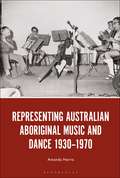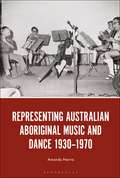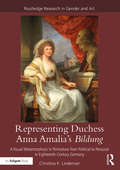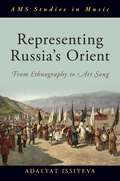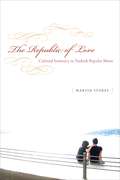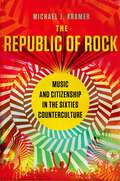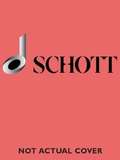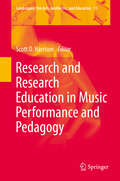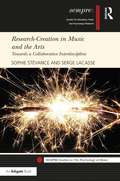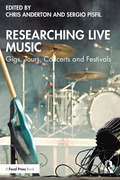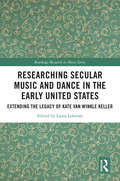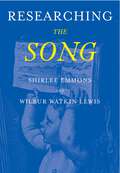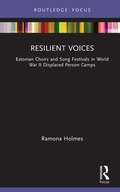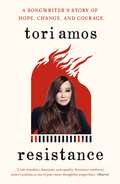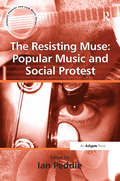- Table View
- List View
Representing Australian Aboriginal Music and Dance 1930-1970
by Amanda HarrisRepresenting Australian Aboriginal Music and Dance 1930-1970 offers a rethinking of recent Australian music history. Amanda Harris presents accounts of Aboriginal music and dance by Aboriginal performers on public stages. Harris also historicizes the practices of non-Indigenous art music composers evoking Aboriginal music in their works, placing this in the context of emerging cultural institutions and policy frameworks. Centralizing auditory worlds and audio-visual evidence, Harris shows the direct relationship between the limits on Aboriginal people's mobility and non-Indigenous representations of Aboriginal culture.This book seeks to listen to Aboriginal accounts of disruption and continuation of Aboriginal cultural practices and features contributions from Aboriginal scholars Shannon Foster, Tiriki Onus and Nardi Simpson as personal interpretations of their family and community histories. Contextualizing recent music and dance practices in broader histories of policy, settler colonial structures, and postcolonizing efforts, the book offers a new lens on the development of Australian musical cultures.
Representing Australian Aboriginal Music and Dance 1930-1970
by Amanda HarrisRepresenting Australian Aboriginal Music and Dance 1930-1970 offers a rethinking of recent Australian music history. Amanda Harris presents accounts of Aboriginal music and dance by Aboriginal performers on public stages. Harris also historicizes the practices of non-Indigenous art music composers evoking Aboriginal music in their works, placing this in the context of emerging cultural institutions and policy frameworks. Centralizing auditory worlds and audio-visual evidence, Harris shows the direct relationship between the limits on Aboriginal people's mobility and non-Indigenous representations of Aboriginal culture.This book seeks to listen to Aboriginal accounts of disruption and continuation of Aboriginal cultural practices and features contributions from Aboriginal scholars Shannon Foster, Tiriki Onus and Nardi Simpson as personal interpretations of their family and community histories. Contextualizing recent music and dance practices in broader histories of policy, settler colonial structures, and postcolonizing efforts, the book offers a new lens on the development of Australian musical cultures.
Representing Duchess Anna Amalia's Bildung: A Visual Metamorphosis in Portraiture from Political to Personal in Eighteenth-Century Germany (Routledge Research in Gender and Art)
by Christina K. LindemanThe cultural milieu in the “Age of Goethe” of eighteenth-century Germany is given fresh context in this art historical study of the noted writers’ patroness: Anna Amalia, Duchess of Weimar-Sachsen-Eisenach. An important noblewoman and patron of the arts, Anna Amalia transformed her court into one of the most intellectually and culturally brilliant in Europe; this book reveals the full scope of her impact on the history of art of this time and place. More than just biography or a patronage study, this book closely examines the art produced by German-speaking artists and the figure of Anna Amalia herself. Her portraits demonstrate the importance of social networks that enabled her to construct scholarly, intellectual identities not only for herself, but for the region she represented. By investigating ways in which the duchess navigated within male-dominated institutions as a means of advancing her own self-cultivation – or Bildung – this book demonstrates the role accorded to women in the public sphere, cultural politics, and historical memory. Cumulatively, Christina K. Lindeman traces how Anna Amalia, a woman from a small German principality, was represented as an active participant in enlightened discourses. The author presents a novel and original argument concerned with how a powerful woman used art to shape her identity, how that identity changed over time, and how people around her shaped it – an approach that elucidates the power of portraiture in eighteenth- and early nineteenth-century Europe.
Representing Duchess Anna Amalia's Bildung: A Visual Metamorphosis in Portraiture from Political to Personal in Eighteenth-Century Germany (Routledge Research in Gender and Art)
by Christina K. LindemanThe cultural milieu in the “Age of Goethe” of eighteenth-century Germany is given fresh context in this art historical study of the noted writers’ patroness: Anna Amalia, Duchess of Weimar-Sachsen-Eisenach. An important noblewoman and patron of the arts, Anna Amalia transformed her court into one of the most intellectually and culturally brilliant in Europe; this book reveals the full scope of her impact on the history of art of this time and place. More than just biography or a patronage study, this book closely examines the art produced by German-speaking artists and the figure of Anna Amalia herself. Her portraits demonstrate the importance of social networks that enabled her to construct scholarly, intellectual identities not only for herself, but for the region she represented. By investigating ways in which the duchess navigated within male-dominated institutions as a means of advancing her own self-cultivation – or Bildung – this book demonstrates the role accorded to women in the public sphere, cultural politics, and historical memory. Cumulatively, Christina K. Lindeman traces how Anna Amalia, a woman from a small German principality, was represented as an active participant in enlightened discourses. The author presents a novel and original argument concerned with how a powerful woman used art to shape her identity, how that identity changed over time, and how people around her shaped it – an approach that elucidates the power of portraiture in eighteenth- and early nineteenth-century Europe.
Representing Russia's Orient: From Ethnography to Art Song (AMS Studies in Music)
by Adalyat IssiyevaThroughout history, Russia's geo-political and cultural position between the East and West has shaped its national identity. Representing Russia's Orient tells the story of how Russia's imperial expansion and encounters with its Asian neighbors influenced the formation and development of Russian musical identity in the long nineteenth century. While Russia's ethnic minorities, or inorodtsy, were located at the geographical and cultural periphery, they loomed large in composers' perception and musical imagination and became central to the definition of Russianness itself. Drawing from a long-forgotten archive of Russian musical examples, visual art, and ethnographies, author Adalyat Issiyeva offers an in-depth study of Russian art music's engagement with oriental subjects. Within a complex matrix of politics, competing ideological currents, and social and cultural transformations, some Russian composers and writers developed multidimensional representations of oriental "others" and sometimes even embraced elements of Asian musical identity. In three detailed case studies--on the leader of the Mighty Five, Milii Balakirev, Decembrist sympathizer Alexander Aliab'ev, and the composers affiliated with the Music-Ethnography Committee--Issiyeva traces how and why these composers adopted "foreign" musical elements. In this way, she provides a fresh look at how Russians absorbed and transformed elements of Asian history and culture in forging a national identity for themselves.
Representing Russia's Orient: From Ethnography to Art Song (AMS Studies in Music)
by Adalyat IssiyevaThroughout history, Russia's geo-political and cultural position between the East and West has shaped its national identity. Representing Russia's Orient tells the story of how Russia's imperial expansion and encounters with its Asian neighbors influenced the formation and development of Russian musical identity in the long nineteenth century. While Russia's ethnic minorities, or inorodtsy, were located at the geographical and cultural periphery, they loomed large in composers' perception and musical imagination and became central to the definition of Russianness itself. Drawing from a long-forgotten archive of Russian musical examples, visual art, and ethnographies, author Adalyat Issiyeva offers an in-depth study of Russian art music's engagement with oriental subjects. Within a complex matrix of politics, competing ideological currents, and social and cultural transformations, some Russian composers and writers developed multidimensional representations of oriental "others" and sometimes even embraced elements of Asian musical identity. In three detailed case studies--on the leader of the Mighty Five, Milii Balakirev, Decembrist sympathizer Alexander Aliab'ev, and the composers affiliated with the Music-Ethnography Committee--Issiyeva traces how and why these composers adopted "foreign" musical elements. In this way, she provides a fresh look at how Russians absorbed and transformed elements of Asian history and culture in forging a national identity for themselves.
The Republic of Love: Cultural Intimacy in Turkish Popular Music (Chicago Studies in Ethnomusicology)
by Martin StokesAt the heart of The Republic of Love are the voices of three musicians—queer nightclub star Zeki Müren, arabesk originator Orhan Gencebay, and pop diva Sezen Aksu—who collectively have dominated mass media in Turkey since the early 1950s. Their fame and ubiquity have made them national icons—but, Martin Stokes here contends, they do not represent the official version of Turkish identity propagated by anthems or flags; instead they evoke a much more intimate and ambivalent conception of Turkishness. Using these three singers as a lens, Stokes examines Turkey’s repressive politics and civil violence as well as its uncommonly vibrant public life in which music, art, literature, sports, and journalism have flourished. However, Stokes’s primary concern is how Müren, Gencebay, and Aksu’s music and careers can be understood in light of theories of cultural intimacy. In particular, he considers their contributions to the development of a Turkish concept of love, analyzing the ways these singers explore the private matters of intimacy, affection, and sentiment on the public stage.
The Republic of Love: Cultural Intimacy in Turkish Popular Music (Chicago Studies in Ethnomusicology)
by Martin StokesAt the heart of The Republic of Love are the voices of three musicians—queer nightclub star Zeki Müren, arabesk originator Orhan Gencebay, and pop diva Sezen Aksu—who collectively have dominated mass media in Turkey since the early 1950s. Their fame and ubiquity have made them national icons—but, Martin Stokes here contends, they do not represent the official version of Turkish identity propagated by anthems or flags; instead they evoke a much more intimate and ambivalent conception of Turkishness. Using these three singers as a lens, Stokes examines Turkey’s repressive politics and civil violence as well as its uncommonly vibrant public life in which music, art, literature, sports, and journalism have flourished. However, Stokes’s primary concern is how Müren, Gencebay, and Aksu’s music and careers can be understood in light of theories of cultural intimacy. In particular, he considers their contributions to the development of a Turkish concept of love, analyzing the ways these singers explore the private matters of intimacy, affection, and sentiment on the public stage.
The Republic of Love: Cultural Intimacy in Turkish Popular Music (Chicago Studies in Ethnomusicology)
by Martin StokesAt the heart of The Republic of Love are the voices of three musicians—queer nightclub star Zeki Müren, arabesk originator Orhan Gencebay, and pop diva Sezen Aksu—who collectively have dominated mass media in Turkey since the early 1950s. Their fame and ubiquity have made them national icons—but, Martin Stokes here contends, they do not represent the official version of Turkish identity propagated by anthems or flags; instead they evoke a much more intimate and ambivalent conception of Turkishness. Using these three singers as a lens, Stokes examines Turkey’s repressive politics and civil violence as well as its uncommonly vibrant public life in which music, art, literature, sports, and journalism have flourished. However, Stokes’s primary concern is how Müren, Gencebay, and Aksu’s music and careers can be understood in light of theories of cultural intimacy. In particular, he considers their contributions to the development of a Turkish concept of love, analyzing the ways these singers explore the private matters of intimacy, affection, and sentiment on the public stage.
The Republic of Rock: Music and Citizenship in the Sixties Counterculture
by Michael J. KramerIn his 1967 megahit "San Francisco," Scott McKenzie sang of "people in motion" coming from all across the country to San Francisco, the white-hot center of rock music and anti-war protests. At the same time, another large group of young Americans was also in motion, less eagerly, heading for the jungles of Vietnam. Now, in The Republic of Rock, Michael Kramer draws on new archival sources and interviews to explore sixties music and politics through the lens of these two generation-changing places--San Francisco and Vietnam. From the Acid Tests of Ken Kesey and the Merry Pranksters to hippie disc jockeys on strike, the military's use of rock music to "boost morale" in Vietnam, and the forgotten tale of a South Vietnamese rock band, The Republic of Rock shows how the musical connections between the City of the Summer of Love and war-torn Southeast Asia were crucial to the making of the sixties counterculture. The book also illustrates how and why the legacy of rock music in the sixties continues to matter to the meaning of citizenship in a global society today. Going beyond clichéd narratives about sixties music, Kramer argues that rock became a way for participants in the counterculture to think about what it meant to be an American citizen, a world citizen, a citizen-consumer, or a citizen-soldier. The music became a resource for grappling with the nature of democracy in larger systems of American power both domestically and globally. For anyone interested in the 1960s, popular music, and American culture and counterculture, The Republic of Rock offers new insight into the many ways rock music has shaped our ideas of individual freedom and collective belonging.
The Republic of Rock: Music and Citizenship in the Sixties Counterculture
by Michael J. KramerIn his 1967 megahit "San Francisco," Scott McKenzie sang of "people in motion" coming from all across the country to San Francisco, the white-hot center of rock music and anti-war protests. At the same time, another large group of young Americans was also in motion, less eagerly, heading for the jungles of Vietnam. Now, in The Republic of Rock, Michael Kramer draws on new archival sources and interviews to explore sixties music and politics through the lens of these two generation-changing places--San Francisco and Vietnam. From the Acid Tests of Ken Kesey and the Merry Pranksters to hippie disc jockeys on strike, the military's use of rock music to "boost morale" in Vietnam, and the forgotten tale of a South Vietnamese rock band, The Republic of Rock shows how the musical connections between the City of the Summer of Love and war-torn Southeast Asia were crucial to the making of the sixties counterculture. The book also illustrates how and why the legacy of rock music in the sixties continues to matter to the meaning of citizenship in a global society today. Going beyond clichéd narratives about sixties music, Kramer argues that rock became a way for participants in the counterculture to think about what it meant to be an American citizen, a world citizen, a citizen-consumer, or a citizen-soldier. The music became a resource for grappling with the nature of democracy in larger systems of American power both domestically and globally. For anyone interested in the 1960s, popular music, and American culture and counterculture, The Republic of Rock offers new insight into the many ways rock music has shaped our ideas of individual freedom and collective belonging.
Research and Research Education in Music Performance and Pedagogy (Landscapes: the Arts, Aesthetics, and Education #11)
by Scott D. HarrisonThis volume is an innovative collection that transcends national boundaries and provides new knowledge about approaches to research and research education in music. The collection brings together leading thinkers and practitioners in music research from Europe, Asia, North America and Australia. The book is designed to serve as a resource for university music departments and conservatoires, and offers insights into the development of research programs in this context.
Research-Creation in Music and the Arts: Towards a Collaborative Interdiscipline (SEMPRE Studies in The Psychology of Music)
by Sophie Stévance Serge LacasseSince the 1970s, the landscape of higher education and research has been considerably altered by the integration of the arts within the university environment. Even though a form of research is inherent to artistic creation, the creative process is not comparable to the established procedures involved in academic research. As such, how can the imperatives of intellectual (and sometimes restrictive) rigour characteristic of scholarly endeavours be reconciled with the more explorative and intuitive approach of artistic creation? The concept of 'research-creation' allows artists and scholars to collaborate on a common project, acknowledging each participant’s expertise in the production of an artistic work that either generates theoretical reflections or has emerged from academic research. This fully revised and updated translation of Sophie Stévance and Serge Lacasse’s original French book offers an overview of the historical, political, social, cultural and academic contexts within which research-creation has emerged in Quebec and Canada, before similar (yet often divergent) conceptions appeared elsewhere in the world. Focussing primarily on the case of music, the book goes on to explore the pedagogical potential of research-creation within a university-based environment and proposes a clear and encompassing definition, as well as a theoretical model, of research-creation supported by concrete examples. By underscoring the reciprocal nature of this approach and the potential benefits of collaborative relationships, the authors’ vision of research-creation extends far beyond the field of music and art alone: rather, it has the potential to integrate all approaches and disciplines that seek to combine practice and research.
Research-Creation in Music and the Arts: Towards a Collaborative Interdiscipline (SEMPRE Studies in The Psychology of Music)
by Sophie Stévance Serge LacasseSince the 1970s, the landscape of higher education and research has been considerably altered by the integration of the arts within the university environment. Even though a form of research is inherent to artistic creation, the creative process is not comparable to the established procedures involved in academic research. As such, how can the imperatives of intellectual (and sometimes restrictive) rigour characteristic of scholarly endeavours be reconciled with the more explorative and intuitive approach of artistic creation? The concept of 'research-creation' allows artists and scholars to collaborate on a common project, acknowledging each participant’s expertise in the production of an artistic work that either generates theoretical reflections or has emerged from academic research. This fully revised and updated translation of Sophie Stévance and Serge Lacasse’s original French book offers an overview of the historical, political, social, cultural and academic contexts within which research-creation has emerged in Quebec and Canada, before similar (yet often divergent) conceptions appeared elsewhere in the world. Focussing primarily on the case of music, the book goes on to explore the pedagogical potential of research-creation within a university-based environment and proposes a clear and encompassing definition, as well as a theoretical model, of research-creation supported by concrete examples. By underscoring the reciprocal nature of this approach and the potential benefits of collaborative relationships, the authors’ vision of research-creation extends far beyond the field of music and art alone: rather, it has the potential to integrate all approaches and disciplines that seek to combine practice and research.
Researching Live Music: Gigs, Tours, Concerts and Festivals
by Chris AndertonResearching Live Music offers an important contribution to the emergent field of live music studies. Featuring paradigmatic case studies, this book is split into four parts, first addressing perspectives associated with production, then promotion and consumption, and finally policy. The contributors to the book draw on a range of methodological and theoretical positions to provide a critical resource that casts new light on live music processes and shows how live music events have become central to raising and discussing broader social and cultural issues. Their case studies expand our knowledge of how live music events work and extend beyond the familiar contexts of the United States and United Kingdom to include examples drawn from Argentina, Australia, France, Jamaica, Japan, New Zealand, Switzerland, and Poland. Researching Live Music is the first comprehensive review of the different ways in which live music can be studied as an interdisciplinary field, including innovative approaches to the study of historic and contemporary live music events. It represents a crucial reading for professionals, students, and researchers working in all aspects of live music.
Researching Live Music: Gigs, Tours, Concerts and Festivals
by Chris Anderton Sergio PisfilResearching Live Music offers an important contribution to the emergent field of live music studies. Featuring paradigmatic case studies, this book is split into four parts, first addressing perspectives associated with production, then promotion and consumption, and finally policy. The contributors to the book draw on a range of methodological and theoretical positions to provide a critical resource that casts new light on live music processes and shows how live music events have become central to raising and discussing broader social and cultural issues. Their case studies expand our knowledge of how live music events work and extend beyond the familiar contexts of the United States and United Kingdom to include examples drawn from Argentina, Australia, France, Jamaica, Japan, New Zealand, Switzerland, and Poland. Researching Live Music is the first comprehensive review of the different ways in which live music can be studied as an interdisciplinary field, including innovative approaches to the study of historic and contemporary live music events. It represents a crucial reading for professionals, students, and researchers working in all aspects of live music.
Researching Secular Music and Dance in the Early United States: Extending the Legacy of Kate Van Winkle Keller (Routledge Research in Music)
by Laura LohmanThis book provides a practical introduction to researching and performing early Anglo-American secular music and dance with attention to their place in society. Supporting growing interest among scholars and performers spanning numerous disciplines, this book contributes quality new scholarship to spur further research on this overshadowed period of American music and dance. Organized in three parts, the chapters offer methodological and interpretative guidance and model varied approaches to contemporary scholarship. The first part introduces important bibliographic tools and models their use in focused examinations of individual objects of material musical culture. The second part illustrates methods of situating dance and its music in early American society as relevant to scholars working in multiple disciplines. The third part examines contemporary performance of early American music and dance from three distinct perspectives ranging from ethnomusicological fieldwork and phenomenology to the theatrical stage. Dedicated to scholar Kate Van Winkle Keller, this volume builds on her legacy of foundational contributions to the study of early American secular music, dance, and society. It provides an essential resource for all those researching and performing music and dance from the revolutionary era through the early nineteenth century.
Researching Secular Music and Dance in the Early United States: Extending the Legacy of Kate Van Winkle Keller (Routledge Research in Music)
by Laura LohmanThis book provides a practical introduction to researching and performing early Anglo-American secular music and dance with attention to their place in society. Supporting growing interest among scholars and performers spanning numerous disciplines, this book contributes quality new scholarship to spur further research on this overshadowed period of American music and dance. Organized in three parts, the chapters offer methodological and interpretative guidance and model varied approaches to contemporary scholarship. The first part introduces important bibliographic tools and models their use in focused examinations of individual objects of material musical culture. The second part illustrates methods of situating dance and its music in early American society as relevant to scholars working in multiple disciplines. The third part examines contemporary performance of early American music and dance from three distinct perspectives ranging from ethnomusicological fieldwork and phenomenology to the theatrical stage. Dedicated to scholar Kate Van Winkle Keller, this volume builds on her legacy of foundational contributions to the study of early American secular music, dance, and society. It provides an essential resource for all those researching and performing music and dance from the revolutionary era through the early nineteenth century.
Researching the Song: A Lexicon
by Shirlee Emmons Wilbur Watkins LewisSingers are faced with a unique challenge among musicians: they must express not just the music, but the lyrics too. To effectively communicate the meaning behind these words, singers must understand the many references embedded in the vast international repertoire of great art songs. They must deal with the meaning of the lyrics, frequently in a language not their own and of a culture unfamiliar to them. From Zelter and Schubert to Rorem and Musto, Researching the Song serves as an invaluable guide for performers, teachers, and enthusiasts to the art song repertoire. Its more than 2,000 carefully researched entries supply information on most of the mythological, historical, geographical, and literary references contained in western art song. The authors explain the meaning of less familiar literary terms, figures, and authors referenced in song while placing songs in the context of larger literary sources. Readers will find entries dealing with art songs from the German, French, Italian, Russian, Spanish, South American, Greek, Finnish, Scandinavian, and both American and British English repertoires. Sources, narratives, and explanations of major song cycles are also given. Organized alphabetically, the lexicon includes brief biographies of poets, lists of composers who set each poet's work, bibliographic materials, and brief synopses of major works from which song texts were taken, including the plots of all Restoration theater works containing Purcell's vocal music. The more performers know and understand the literary elements of a song, the richer their communication will be. Researching the Song is a vital aid for singers and teachers in interpreting art songs and building song recital programs.
Researching the Song: A Lexicon
by Shirlee Emmons Wilbur Watkins LewisSingers are faced with a unique challenge among musicians: they must express not just the music, but the lyrics too. To effectively communicate the meaning behind these words, singers must understand the many references embedded in the vast international repertoire of great art songs. They must deal with the meaning of the lyrics, frequently in a language not their own and of a culture unfamiliar to them. From Zelter and Schubert to Rorem and Musto, Researching the Song serves as an invaluable guide for performers, teachers, and enthusiasts to the art song repertoire. Its more than 2,000 carefully researched entries supply information on most of the mythological, historical, geographical, and literary references contained in western art song. The authors explain the meaning of less familiar literary terms, figures, and authors referenced in song while placing songs in the context of larger literary sources. Readers will find entries dealing with art songs from the German, French, Italian, Russian, Spanish, South American, Greek, Finnish, Scandinavian, and both American and British English repertoires. Sources, narratives, and explanations of major song cycles are also given. Organized alphabetically, the lexicon includes brief biographies of poets, lists of composers who set each poet's work, bibliographic materials, and brief synopses of major works from which song texts were taken, including the plots of all Restoration theater works containing Purcell's vocal music. The more performers know and understand the literary elements of a song, the richer their communication will be. Researching the Song is a vital aid for singers and teachers in interpreting art songs and building song recital programs.
Resilient Voices: Estonian Choirs and Song Festivals in World War II Displaced Person Camps
by Ramona HolmesThe aftermath of World War II sent thousands of Estonian refugees into Europe. The years of Estonian independence (1917-1940) had given them a taste of freedom and so relocation to displaced person (DP) camps in post-war Germany was extremely painful. One way in which Estonians dealt with the chaos and trauma of WWII and its aftermath was through choral singing. Just as song festivals helped establish national identity in 1869, song festivals promoted cultural cohesiveness for Estonians in WWII displaced person camps. A key turning point in hope for the Estonian DPs was the 1947 Augsburg Song Festival, which is the center point of this book. As Estonian DPs dispersed to Australia, Canada, Europe, and the United States these choirs and song festivals gave Estonians the resilience to retain their identity and to thrive in their new homes. This history of Estonian WWII DP camp choirs and song festivals is gathered from the stories of many courageous individuals and filled with the tenacious spirit of the Estonian singing culture. This work contributes to an understanding of immigration, identity, and resilience and is particularly important within the field of music regarding music and healing, music and identity, historical musicology, ethnomusicology, and music and politics.
Resilient Voices: Estonian Choirs and Song Festivals in World War II Displaced Person Camps
by Ramona HolmesThe aftermath of World War II sent thousands of Estonian refugees into Europe. The years of Estonian independence (1917-1940) had given them a taste of freedom and so relocation to displaced person (DP) camps in post-war Germany was extremely painful. One way in which Estonians dealt with the chaos and trauma of WWII and its aftermath was through choral singing. Just as song festivals helped establish national identity in 1869, song festivals promoted cultural cohesiveness for Estonians in WWII displaced person camps. A key turning point in hope for the Estonian DPs was the 1947 Augsburg Song Festival, which is the center point of this book. As Estonian DPs dispersed to Australia, Canada, Europe, and the United States these choirs and song festivals gave Estonians the resilience to retain their identity and to thrive in their new homes. This history of Estonian WWII DP camp choirs and song festivals is gathered from the stories of many courageous individuals and filled with the tenacious spirit of the Estonian singing culture. This work contributes to an understanding of immigration, identity, and resilience and is particularly important within the field of music regarding music and healing, music and identity, historical musicology, ethnomusicology, and music and politics.
Resistance: A Songwriter’s Story of Hope, Change and Courage
by Tori AmosSince the release of her first, career-defining solo album Little Earthquakes, Tori Amos has been one of the music industry's most enduring and ingenious artists. From her unnerving depiction of sexual assault in "Me and a Gun" to her post-9/11 album Scarlet's Walk to her latest album Native Invader, her work has never shied away from intermingling the personal with the political. Amos began playing piano as a teenager for the politically powerful at hotel bars in Washington, D.C., during the formative years of the post-Goldwater and then Koch-led Libertarian and Reaganite movements. The story continues to her time as a hungry artist in L.A. to the subsequent three decades of her formidable music career. Amos explains how she managed to create meaningful, politically resonant work against patriarchal power structures-and how her proud declarations of feminism and her fight for the marginalized always proved to be her guiding light. She teaches readers to engage with intention in this tumultuous global climate and speaks directly to supporters of #MeToo and #TimesUp, as well as young people fighting for their rights and visibility in the world. Filled with compassionate guidance and actionable advice-and using some of the most powerful, political songs in Amos's canon-this book is for readers determined to steer the world back in the right direction.
The Resisting Muse: Popular Music and Social Protest (Ashgate Popular and Folk Music Series)
by Ian PeddiePopular music has traditionally served as a rallying point for voices of opposition, across a huge variety of genres. This volume examines the various ways popular music has been deployed as anti-establishment and how such opposition both influences and responds to the music produced. Implicit in the notion of resistance is a broad adversarial hegemony against which opposition is measured. But it would be wrong to regard the music of popular protest as a kind of dialogue in league against 'the establishment'. Convenient though they are, such 'us and them' arguments bespeak a rather shop-worn stance redolent of youthful rebellion. It is much more fruitful to perceive the relationship as a complex dialectic where musical protest is as fluid as the audiences to which it appeals and the hegemonic structures it opposes. The book's contemporary focus (largely post-1975) allows for comprehensive coverage of extremely diverse forms of popular music in relation to the creation of communities of protest. Because such communities are fragmented and diverse, the shared experience and identity popular music purports is dependent upon an audience collectivity that is now difficult to presume. In this respect, The Resisting Muse examines how the forms and aims of social protest music are contingent upon the audience's ability to invest the music with the 'appropriate' political meaning. Amongst a plethora of artists, genres, and themes, highlights include discussions of Aboriginal rights and music, Bauhaus, Black Sabbath, Billy Bragg, Bono, Cassette culture, The Capitol Steps, Class, The Cure , DJ Spooky, Drum and Bass, Eminem, Farm Aid, Foxy Brown, Folk, Goldie, Gothicism, Woody Guthrie, Heavy Metal, Hip-hop, Independent/home publishing, Iron Maiden, Joy Division, Jungle, Led Zeppelin, Lil'Kim, Live Aid, Marilyn Manson, Bob Marley, MC Eiht, Minor Threat, Motown, Queen Latifah, Race, Rap, Rastafarianism, Reggae, The Roots, Diana Ross, Rush, Salt-n-Pepa, 7 Seconds, Roxanne Shanté, Siouxsie and the Banshees, The Sisters of Mercy, Michelle Shocked, Bessie Smith, Straight edge Sunrize Band, Bunny Wailer, Wilco, Bart Willoughby, Wirrinyga Band, Zines.
